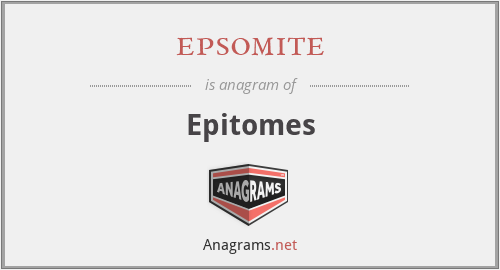What anagrams are available for Epitomes?
This page is about an anagram for the word epsomite that can be used in word games, puzzles, trivia and other crossword based board games.
epsomite
Translation
Find a translation for epsomite in other languages:
Select another language:
- - Select -
- 简体中文 (Chinese - Simplified)
- 繁體中文 (Chinese - Traditional)
- Español (Spanish)
- Esperanto (Esperanto)
- 日本語 (Japanese)
- Português (Portuguese)
- Deutsch (German)
- العربية (Arabic)
- Français (French)
- Русский (Russian)
- ಕನ್ನಡ (Kannada)
- 한국어 (Korean)
- עברית (Hebrew)
- Gaeilge (Irish)
- Українська (Ukrainian)
- اردو (Urdu)
- Magyar (Hungarian)
- मानक हिन्दी (Hindi)
- Indonesia (Indonesian)
- Italiano (Italian)
- தமிழ் (Tamil)
- Türkçe (Turkish)
- తెలుగు (Telugu)
- ภาษาไทย (Thai)
- Tiếng Việt (Vietnamese)
- Čeština (Czech)
- Polski (Polish)
- Bahasa Indonesia (Indonesian)
- Românește (Romanian)
- Nederlands (Dutch)
- Ελληνικά (Greek)
- Latinum (Latin)
- Svenska (Swedish)
- Dansk (Danish)
- Suomi (Finnish)
- فارسی (Persian)
- ייִדיש (Yiddish)
- հայերեն (Armenian)
- Norsk (Norwegian)
- English (English)
Definition
What does Epitomes mean?
- epitomes
- An epitome (; Greek: ἐπιτομή, from ἐπιτέμνειν epitemnein meaning "to cut short") is a summary or miniature form, or an instance that represents a larger reality, also used as a synonym for embodiment. Epitomacy represents "to the degree of." An abridgment differs from an epitome in that an abridgment is made of selected quotations of a larger work; no new writing is composed, as opposed to the epitome, which is an original summation of a work, at least in part. Many documents from the Ancient Greek and Roman worlds survive now only "in epitome," referring to the practice of some later authors (epitomators) who wrote distilled versions of larger works now lost. Some writers attempted to convey the stance and spirit of the original, while others added further details or anecdotes regarding the general subject. As with all secondary historical sources, a different bias not present in the original may creep in. Documents surviving in epitome differ from those surviving only as fragments quoted in later works and those used as unacknowledged sources by later scholars, as they can stand as discrete documents but refracted through the views of another author. Epitomes of a kind are still produced today when dealing with a corpus of literature, especially classical works often considered dense, unwieldy and unlikely to be read by the average person, to make them more accessible: some are more along the lines of abridgments, such as many which have been written of Edward Gibbon's The History of the Decline and Fall of the Roman Empire, a work of six large volumes (about 3600 pages) often published as one volume of about 1400 pages. Some are of the same type as the ancient epitome, such as various epitomes of the Summa Theologiae of Thomas Aquinas, originally written as an introductory textbook in theology and now accessible to very few except for the learned in theology and Aristotelian philosophy, such as A Summa of the Summa and A Shorter Summa. Many epitomes today are published under the general title "The Companion to ...", such as The Oxford Companion to Aristotle, or "An Overview of ...", or "guides," such as An Overview of the Thought of Immanuel Kant, How to Read Hans Urs von Balthasar, or, in some cases, as an introduction, in the cases of An Introduction to Søren Kierkegaard or A Very Short Introduction to the New Testament (many philosophical "introductions" and "guides" share the epitomic form, unlike general "introductions" to a field).
Embed
Citation
Use the citation below to add this anagram to your bibliography:
Style:MLAChicagoAPA
"epsomite." Anagrams.net. STANDS4 LLC, 2024. Web. 29 Apr. 2024. <https://www.anagrams.net/term/32405566>.



Discuss this Epitomes anagram with the community:
Report Comment
We're doing our best to make sure our content is useful, accurate and safe.
If by any chance you spot an inappropriate comment while navigating through our website please use this form to let us know, and we'll take care of it shortly.
Attachment
You need to be logged in to favorite.
Log In